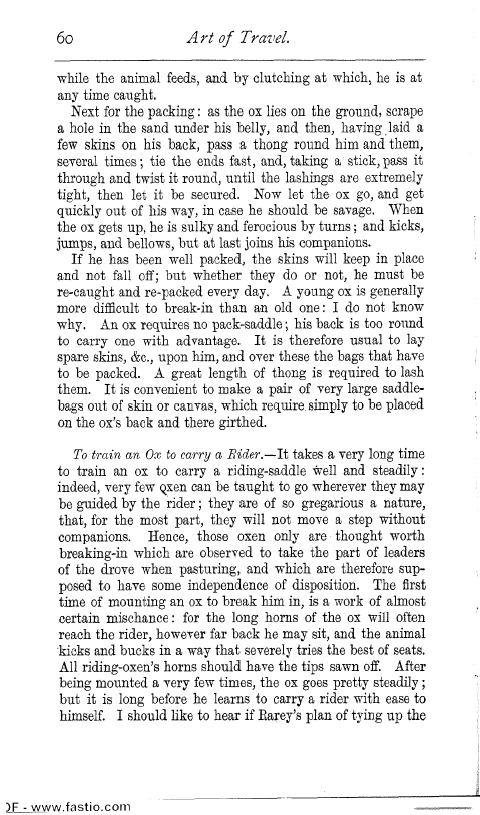| ||||||

OCR Rendition - approximate6o Art of Travel. while the animal feeds, and by clutching at which, he is at any time caught. Next for the packing : as the ox lies on the ground, scrape a hole in the sand under his belly, and then, having.laid a few skins on his back, pass a thong round him and them, several times ; tie the ends fast, and, taking a stick, pass it through and twist it round, until the lashings are extremely tight, then let it be secured. Now let the ox go, and get quickly out of his way, in case he should be savage. When the ox gets up, he is sulky and ferocious by turns ; and kicks, jumps, and bellows, but at last joins his companions. If he has been well packed, the skins will keep in place and not fall off; but whether they do or not, he must be re-caught and re-packed every day. A young ox is generally more difficult to break-in than an old one : I do not know why. An ox requires no pack-saddle ; his back is too round to carry one with advantage. It is therefore usual to lay spare skins, &c., upon him, and over these the bags that have to be packed. A great length of thong is required to lash them. It is convenient to make a pair of very large saddlebags out of skin or canvas, which regiiire.simply to be placed on the ox's back and there girthed. To train an Ox to carry a Rider.-It takes a very long time to train an ox to carry a riding-saddle *ell and steadily indeed, very few Qxen can be taught to go wherever they may be guided by the rider ; they are of so gregarious a nature, that, for the most part, they will not move a step without companions. Hence, those oxen only are thought worth breaking-in which are observed to take the part of leaders of the drove when pasturing, and which are therefore supposed to have some independence of disposition. The first time of mounting an ox to break him in, is a work of almost certain mischance : for the long horns of the ox will often reach the rider, however far back he may sit, and the animal kicks and bucks in a way that severely tries the best of seats. All riding-oxen's horns should have the tips sawn off. After being mounted a very few times, the ox goes pretty steadily ; but it is long before he learns to carry a rider with ease to himself. I should like to hear if Rarey's plan of tying up the )F - www.fastio.com |